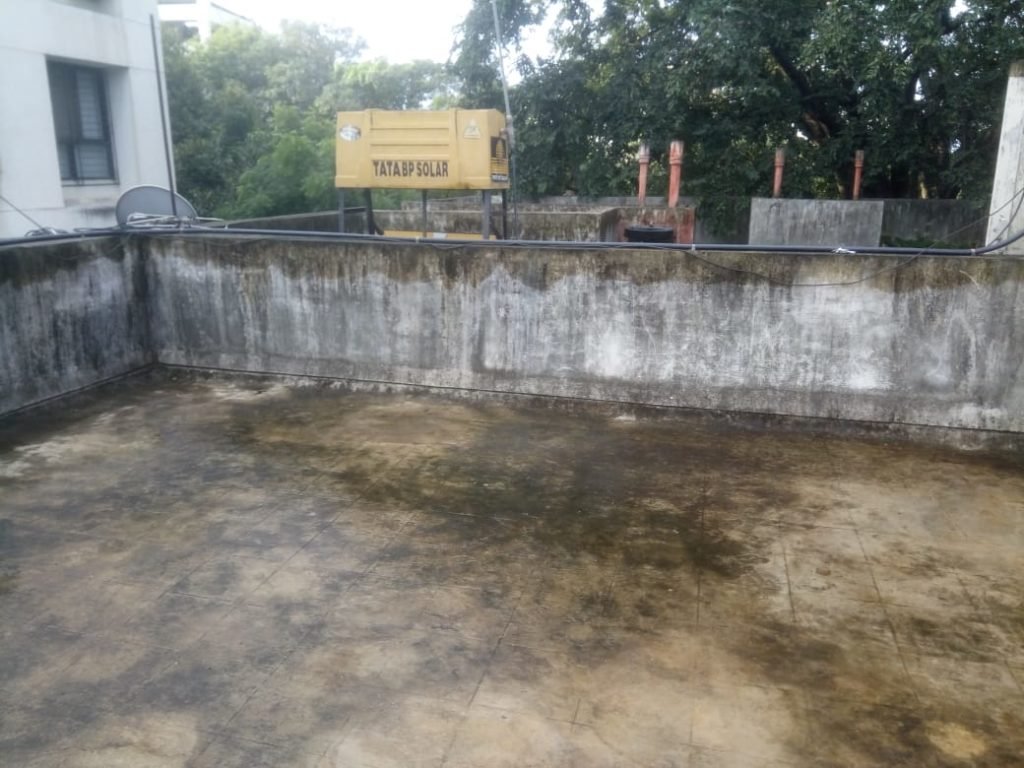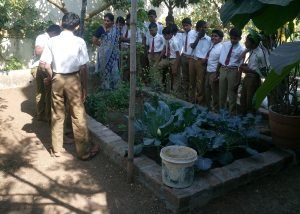Well, the thought of “growing our own food” is wonderful. I decided to give it a try.
Making a salad? Just pick up a tomato and cucumber from the terrace, pluck a few leaves of mint here and basil there. Wow! That is the dream.
No traces of chemical fertilizers, no toxic pesticides. fresh, toxic-free vegetables, just a PLUCK-AWAY..
After the initial euphoria was over, reality struck.
How to achieve it?
My terrace, yet another patch of concrete among surrounding concrete jungle;

At times, it is impossible to step in the terrace, during the day. Concrete heats up so bad. Direct sunlight is fine, but how plants will manage to survive from this heat from concrete?
What about soil? Do I just go out and scoop some up for my terrace garden?
Thus, began my search for my own food amongst all these constraints.
The biggest one was my near-to-nothing-knowledge about cultivating edible garden.
I did the most logical thing, I turned to books, Internet, fellow urban-gardeners.
Gradually through discussions something remarkable happened. Things I thought were the constraints, those very things turned out to be blessings.
I realized we live in such an abundance. Everything I needed, to create a terrace garden was already there. All I needed to do was appreciate that and adjust my attitude towards positive, a bit 😊
That’s all and a wonderful world of opportunities opened.
I see many good intentions discouraged. Many items remain on wish-list forever, simple because we focus too much on constraints.
Hence, I decided to create this in-depth blog to open that great world of opportunities to city-dwellers and help you get on with your terrace garden.
First and foremost, small is beautiful!!
You want to do anything; mulching, sowing, compost, watering? All you must worry about is a tiny area of a few hundred square feet. Imagine a farmer, planning an intervention for acres and acres of land. All costs, efforts go up. A farmer needs huge upfront investment, a lot of human resource, so many dependencies.
Yes, these are sides of the same coin. In a city, you have shortage of space. Yet, this very fact works for you when it comes to using resources.
Let’s go over various resources one needs for garden
Soil
Okkay, soil, or rather lack of it is the challenge. How to get all that soil?
Buying soil anyway is not advisable. Please don’t, we request you. (Please refer here to our blog to know why/9.
YOU DO NOT NEED TO BUY soil. There is an alternative. If you provide plants, all the nutrients they get from the soil, you can do gardening without soil.
Use compost made from dry leaves and kitchen waste.

Come November and dry leaves are in abundance. Streets, Footpaths, Society premises; There are a lot of leaves and they are just everywhere.
Trees that shed leaves for some time of the year, are known as deciduous trees. In tropical country like us, trees shed leaves as preparation for summer. Trees lose water through leaves. Shedding leaves helps them conserve water. Layer of fallen leaves on the soil protect soil from the sun. Thus, soil is also able to retain moisture. More on this here (why trees shed leaves)
How to get dry leaves? Don’t worry, there are so any people around you who would be happy to donate them to you. In fact, that how this initiative, Brown leaf was born. Read this blog for more details (Donate)
Water
Watering acres and acres of land needs planning. A reliable source of water, a mighty instrument to pump that water. What if there is electricity failure? Load-shedding? In case of these eventualities, how to water such a vast expanse of land?
Consider your garden. How much water a few hundred square feet of land/ terrace needs? A few buckets? Arranging it is not a difficult task, is it?
Most of us have overhead tanks. We don’t need to carry water up. It is already been pumped in the tanks for drinking and other uses. All we do is borrow some of it for the garden. We do not need to do anything EXTRA.
Watering the whole garden is a matter of minutes. We can hire help or do it ourselves. Still doable, right?
Whether it is soil or no-soil; organic matter is needed for good yield. Keeping acres of acres of land, its soil, nutrient-rich is no easy task. Much easier when you have a garden or terrace garden.
Keep adding kitchen-waste, dry leaves and you are set.
Mulching
Mulching is covering soil with dry leaves/ hay. It forms a protecting layer over the soil, thus protecting it from the harsh sun. Soil can retain moisture. It also acts as shock absorbent. When we water, a disturbance is created. When watering with pipe, the flow runs down too quickly. With mulching, it is gradually absorbed. Roots get much needed moisture for a long time. Rapid flow also carries away nutrients from the soil/ compost. Since mulching breaks speed of water, it also preserves nutrients.
Leaf fall is over, and you do not have dry leaves, what do you do? Hay is used to protect fruits in transport. Your fruit vendor will be happy to donate you the hay, which they anyway throw away, once fruits are unpacked.
Saw dust is available from wood mills, which can be used in place of dry leaves.
Fertilizers
Some plants require an extra dose of calcium. We have a source of calcium readily available in our kitchen, egg shells? Just crush them and supply them to the container/ plant bed.
Many students come to city for education. Many people move to city for employment opportunities. To cater to their needs, eateries have become a huge industry in the city. Approach any “Anda Burji” cart around the corner and ask for egg shells. Again, it is a win-win situation. That person gets rid of “waste” and you get large amount of calcium in one go.
Same arrangement can be set-up with vegetable vendors. You will find excess/ stale vegetables left to rot by roadside. Collect such vegetables from the vendor. Greens provide nitrogen much needed for growth of microbes. And guess what, you also help keep your city clean. Blessings, blessing, all the way.
Pesticides
Neem oil, Jeevamrut, tobacco extract; are some of the natural pesticides. With awareness about organic gardening, jeevamrut is available in cities. Usually the cow owners prepare and sell it to supplement their income. Inquire with fellow gardeners to know the nearest source.
Seeds
Visit any garden shop, buy 2-3 packets of seeds and done, you are ready for the first sowing. Investment? Around Rs. 50. Labor? Almost none.
We often talk about disconnect with neighbors in the city. At the same time, a city is a wonderfully connected community. Transport facilities, Internet, Social media enable us to connect with people in all corners of the city.
Whatsapp garden groups, nature lover groups exist in the city. When we buy seed packets, due to limitation of space, we rarely sow the whole quantity. Seasoned gardeners always have a few seeds in excess.
If we connect to any garden group, we might receive seeds for free for the first sowing. So, for 50 rupees or less, we are ready for first round of cultivation.
A farmer does not have this luxury. Farmers need major investment simply to buy seeds.
Variety of seeds enter our garden when we use kitchen waste. Water melon, Musk melon, Guava, Custard Apple, Bitter Gourd, Tomato seeds easily sprout in the compost, without us taking any efforts. I personally never bought bitter gourd seeds. Yet we have bitter gourd subji every week. All thanks to the first batch of bitter gourds that I bought from the market. From seeds of that batch, we have several plants and weekly harvest.
You buy once and then create seeds for next harvest. E.g. if you buy/borrow white gourd seeds to start with. When you have white gourd produce, do not pluck all of them. Let one remain on the creeper to dry naturally. Once it is completely dry, remove seeds and store in paper envelope to use for sowing. Thus, you create a cycle.
Saplings
Sapling exchange is a gratifying activity. Many garden groups meet regularly and exchange saplings at the meets. You have something that you cannot accommodate on the terrace. At the same time, there is somebody who can make use of it. What an opportunity to bring together “Availability” and “Requirement”.
Conclusion
So? Have I convinced you? 🙂 Or I can keep writing and writing about this topic till I do…
Believe me, urban gardening is not such a challenge as it initially seems. Just look around and you will find resources, guidance, advice, just about everything. Start with what you have, put your heart into it and within no time, you will have your green dream come true.
HAPPY GARDENING!!




👍🏻